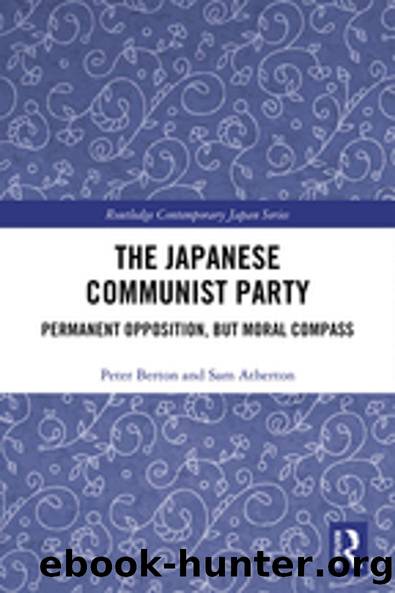The Japanese Communist Party by Peter Berton Sam Atherton

Author:Peter Berton, Sam Atherton [Peter Berton, Sam Atherton]
Language: eng
Format: epub
Tags: Social Science, Ethnic Studies, General, Regional Studies
ISBN: 9781351857819
Google: ntFfDwAAQBAJ
Publisher: Routledge
Published: 2018-06-12T00:19:58+00:00
Notes
1Sei Young Rhee, âThe Impact of the Sino-Soviet Conflict on the Japanese Communist Party, 1961â1968,â Ph.D. Dissertation, University of Missouri, 1973, 428pp; and Margarete Donath, âDie Kommunistische Partei Japans zwischen Peking und Moskauâ (The JCP between Peking and Moscow), Osteuropa, Vol. 27, Part 8 (August 1977), pp. 702â16.
2For a JCP account of these CPSU activities, see âOn Interventions in and Subversive Activities Against the Democratic Movements of Our Country and Our Party by the CPSU Leadership and the Institutions and Organizations Under Its Guidance,â Akahata, June 22, 1965, Bulletin, No. 41; reprinted as a separate pamphlet by the Foreign Languages Press in Beijing in 1965.
Since 1965, the Party Central Committee Publishing Bureau has been putting out a collection of documents on international affairs: Nihon Kyosan To JūyŠRombun Shū (Collection of Important Documents of the JCP). After publication of Vol. 9, the title was changed to Nihon Kyosan To Kokusai Mondai JūyŠRombun Shū (Collection of Important Documents of the JCP on International Problems).
3This account is based on âThe Great Dispute with Suslovâ in Hakamada Satoshi, Watakushi no sengo shi (My Postwar History), Tokyo: Asahi Shimbunsha, 1978, pp. 184â90.
4Ibid., p. 188.
5Ibid., p. 189.
6Ibid. Actually, the 1951 document was reportedly drafted by Suslov, and after Stalinâs approval translated by Nosaka into Japanese. Fukuyama Hideharu, âSoren no tai-Nichi seisakuâsono rekishi to genjÅâ (Soviet policy toward Japan: its history and present state of affairs), Koan joho, No. 346 (July 1982), p. 18.
7Some of the topics taken up at these secret talks were revealed when, on July 18, 1964, the Soviet Party made public its April 18 letter to the JCP, and the Japanese Party replied on August 26, 1964 (Akahata, September 2).
For an analysis of the issues in the dispute, see Scalapino, Scalapino, The Japanese Communist Movement, 1920â1966, Berkeley: University of California Press, 1967, p. 169ff. See also âOn Interventions in and Subversive Activities Against the Democratic Movements of Our Country and Our Party by the CPSU Leadership and the Institutions and Organizations Under Its Guidance,â Akahata, June 22, 1965, Bulletin, No. 41 (June 1965); also published as a pamphlet by the Foreign Languages Press in Beijing in 1966, 47pp.
8Hakamada, op. cit., p. 190.
9Akahata, November 22, 1964. This definitive JCP statement, âOn the Intrinsic Nature of N. S. Khrushchevâs Peaceful Co-existence Line,â was reprinted as a separate pamphlet by the Foreign Languages Press in Beijing in 1965. CPSUâs letters to the JCP dated April 18 and July 11, 1964 are reproduced in Soviet Documents (New York), Vol. 2, No. 35 (August 31, 1964), pp. 3â35. See also Paul F. Langer, âIndependence or Subordination: The Japanese Communist Party Between Moscow and Peking,â in A. Doak Barnett, ed., Communist Strategies in Asia: A Comparative Analysis of Governments and Parties, New York: Praeger, 1963, pp. 63â100; and Hans H. Baerwald, âThe Japanese Communist Party: Yoyogi and Its Rivalsâ in Robert A. Scalapino, ed., The Communist Revolution in Asia: Tactics, Goals, and Achievements, Englewood Cliffs, NJ: Prentice-Hall, 1965, pp. 198â220. Baerwald interviewed Shiga in his Diet office in August 1963.
Download
This site does not store any files on its server. We only index and link to content provided by other sites. Please contact the content providers to delete copyright contents if any and email us, we'll remove relevant links or contents immediately.
The Secret History by Donna Tartt(18860)
The Social Justice Warrior Handbook by Lisa De Pasquale(12143)
Thirteen Reasons Why by Jay Asher(8800)
This Is How You Lose Her by Junot Diaz(6802)
Weapons of Math Destruction by Cathy O'Neil(6152)
Zero to One by Peter Thiel(5692)
Beartown by Fredrik Backman(5609)
The Myth of the Strong Leader by Archie Brown(5429)
The Fire Next Time by James Baldwin(5252)
How Democracies Die by Steven Levitsky & Daniel Ziblatt(5133)
Promise Me, Dad by Joe Biden(5089)
Stone's Rules by Roger Stone(5028)
A Higher Loyalty: Truth, Lies, and Leadership by James Comey(4851)
100 Deadly Skills by Clint Emerson(4845)
Rise and Kill First by Ronen Bergman(4705)
Secrecy World by Jake Bernstein(4652)
The David Icke Guide to the Global Conspiracy (and how to end it) by David Icke(4629)
The Farm by Tom Rob Smith(4442)
The Doomsday Machine by Daniel Ellsberg(4420)
